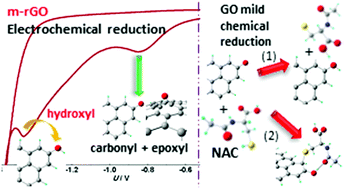A comparative experimental and theoretical study of the mechanism of graphene oxide mild reduction by ascorbic acid and N-acetyl cysteine for biomedical applications†
Abstract
A first comparison of the behavior of N-acetyl cysteine (NAC) and ascorbic acid (H2A) towards reduction of graphene oxide (GO) is reported, along with the novel proposition of the associated reaction mechanisms. NAC and H2A are green multi-valent reducing agents, which lead to a mild and biocompatible chemical reduction of oxygenated functional groups in GO. Such reduction has been demonstrated to significantly improve the suitability of GO as a substrate in biomedical applications. A sequence of electrochemical and spectroscopic experiments, theoretical computations and biological tests has been applied to two related series of GO samples mildly reduced with NAC and H2A. These display a downshift of the electrochemical reduction potential characteristic of epoxyl and carbonyl functional groups, associated with an increase in the electron affinity of the substrates. This potential shift, in turn, makes visible a not previously reported reduction feature, associated with hydroxyl groups. Theoretical modelling unveils the reduction mechanisms operating for H2A and NAC on the GO surface, showing their similarity, but also evidencing that NAC remains permanently bonded to the GO surface after reduction, altering the overall reactivity of the reduced GO samples. The mild reduction effect exerted by NAC is stronger in generating attractive biochemical characteristics on GO when compared to H2A. In fact, while administration of NAC to eukaryotic cell lines does not affect the cell viability, this is instead reduced in the case of H2A. The resulting mildly reduced GO materials represent a new step in the direction of GO derivatives with tailored functionalities and oxidation degree for optimized biomedical applications.



 Please wait while we load your content...
Please wait while we load your content...